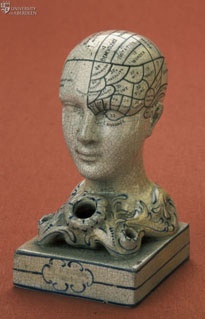A gorilla skull, a life cast of an African Bushwoman and a railway telegraph receiver are three of the fascinating objects making up a new exhibition at Marishcal Museum.
English students at the University of Aberdeen have helped curate Frankenstein to Einstein, an exhibition exploring the complex links between science and literature in the nineteenth century.
"In the Victorain era the boundary between scientific writing and imaginative literature was not as clearly marked as it is now," explained Dr Hazel Hutchison, who co-ordinated the English course that led to the exhibition. "Scientific texts were often written in a poetic, imaginative way, while many fictional works took inspiration from contemporary science."
One focus of the exhibition is the work and fossil finds of Cromarty-born Hugh Miller (1802-1856) who became a household name across Scotland as the firebrand editor of the Evangelical newspaper The Witness, writing editorials on everything from politics and religion to popular science.
Fossils he discovered and some of his written work feature in the Marischal exhibition.
"Miller helped to popularise geology in texts such as his hugely popular work The Old Red Sandstone (1841) which featured vivid descriptions of fossils he found on his local beach," said Dr Hutchison. "However, while many scientists saw geology as a challenge to religious beliefs, Miller interpreted his findings as proof of God's hand in creation."
The nature versus nurture debate was fervent in the 19th century and was reflected in popular literature such as Mary Shelley's Frankenstein (1818). A second-edition of the book dating back to 1831 features in the exhibition alongside other treasures such as a male gorilla skull collected by John Struthers, Professor of Anatomy at the University of Aberdeen from 1863-1880, and a committed Darwinian.
A life cast of a Khoisan Bushwoman on display also raises questions about the attitudes of European collectors to African peoples, while a morse key and railway telegraph receiver form other individual exhibits.
"Because of the growth of the British Empire, there was also a particular interest in the differences between races, and in technologies of time, travel and communication such as railways, telegraphs and watches," added Dr Hutchison.
She said putting together the exhibition had been a great learning experience for her students.
"Getting up close to an object – whether it is a fossil, a telegraph receiver or a rare book – is always very different to hearing about it in a lecture. And now, other people will get the chance to see what we have been discovering."
Neil Curtis, Marischal Museum's Senior Curator added: "This exhibition brings current university research and teaching to life for museum visitors. I have been particularly impressed by the knowledge and enthusiasm of everyone involved. It is not easy translating difficult ideas into such an interesting and accessible exhibition."
The Frankenstein to Einstein exhibition is open now and runs until the end of June 2008.
Marischal Museum is located in Marischal College in the centre of Aberdeen. The museum is open Monday to Friday, 10am – 5pm and Sunday 2pm – 5pm. Entry to the museum is free.


